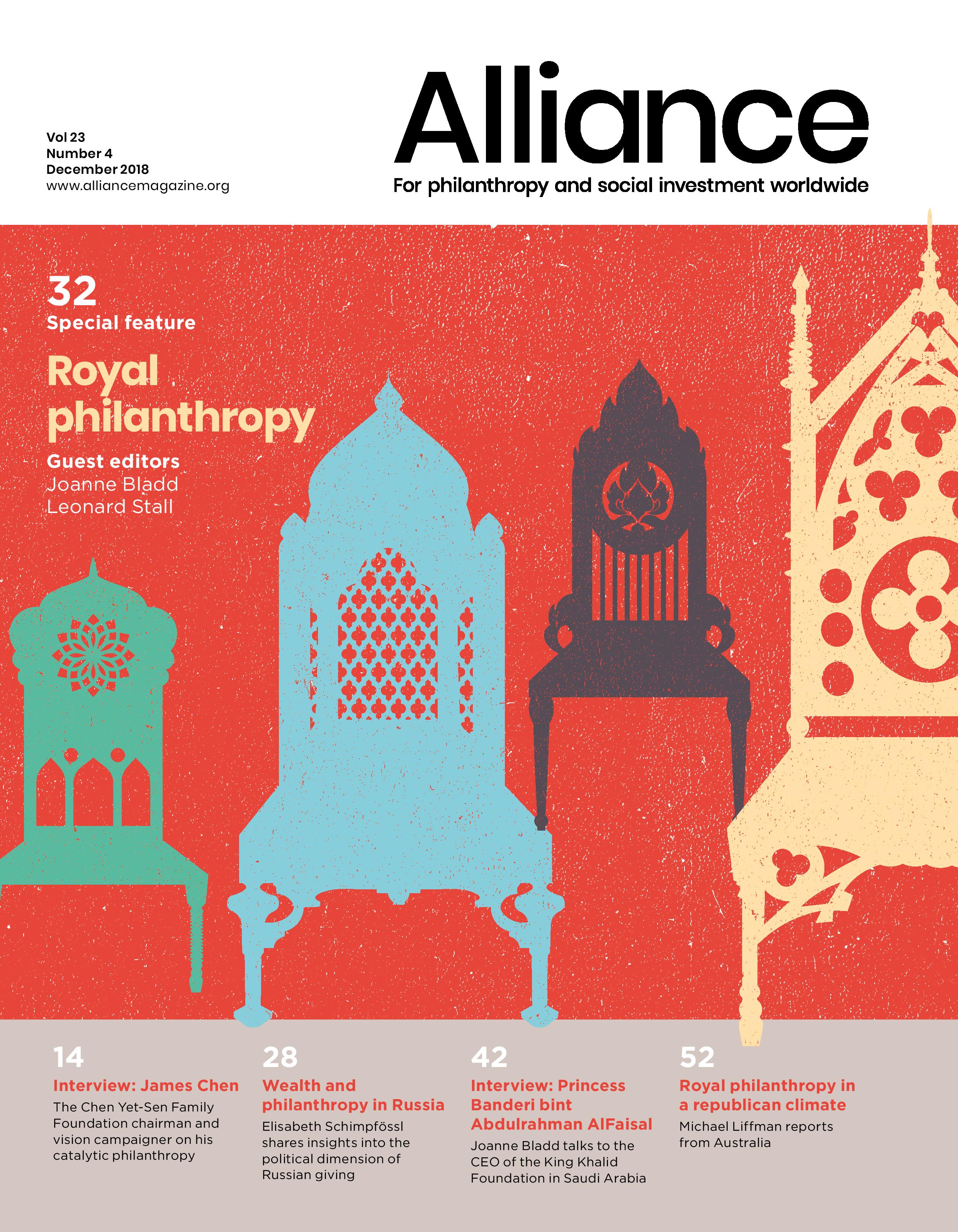Royal giving can be a powerful force for progress but faces pressure to adapt and demonstrate its value to contemporary society
At a time when the charitable giving of the world’s rich is under public scrutiny, royal philanthropy rarely makes the headlines. The two have much in common – both involve the use of private money, influence or prestige for ostensibly public good – but royal giving slips under the radar in a way that large-scale donations by billionaires do not. This is partly because the ties between philanthropy and royalty are often seen as symbolic and largely ineffective – another day, another ribbon-cutting – and also because it is a partnership that has hummed along quietly for so long, we barely recognise it as a distinctive phenomenon.
But there is value in holding royal philanthropy up to the light. A practice that was once synonymous with light-touch patronage has, in some cases, evolved into impactful giving. What began as a way to recast privilege as benevolence has today turned into royal families and foundations bringing much-needed clout and cash to bear on neglected causes.
In the Gulf, royal philanthropy was in many ways an extension of the social contract between citizen and state. In the same way that the region’s oil and gas revenues were used to provide extensive welfare benefits to citizens, acts of philanthropy were seen as further evidence of the generosity of paternalistic rulers – whether carried out at home, or abroad. Sheikh Zayed bin Sultan Al Nahyan, the founding father of the UAE, neatly captured this dynamic in his response to a foreign journalist in Geneva in 1996. Asked why he spent so much money on his people, Sheikh Zayed replied: ‘If you have money, won’t you spend it on your children? All my people are my children.’
This ethos remains, but royal philanthropy in the region has grown more strategic. The Gulf’s overseas giving in particular has stretched beyond simply cheque writing to active participation and diplomatic influence. The Crown Prince of Abu Dhabi Sheikh Mohammed bin Zayed, for example, has given more than $150 million in personal and state funds to help combat polio, while also leveraging the UAE’s status as a Muslim ally to deliver immunisations in high-risk areas of Pakistan and Afghanistan that had resisted previous vaccination campaigns.
Its raft of initiatives – which span from the Dubai-based logistics hub, International Humanitarian City, to the education charity Dubai Cares – are loosely united by the goal of improving the Arab region through humanitarian, development and community work.
In 2017, Sheikh Mohammed bin Zayed joined with the Bill & Melinda Gates Foundation to launch a $100 million fund focused on tackling neglected tropical diseases, a cause that has received little attention in the Middle East. Reaching the Last Mile Fund, a 10-year facility hosted by the END Fund, plans to eliminate river blindness and lymphatic filariasis from seven countries in Africa and the Middle East. The crown prince pledged $20 million to the fund, and the Gates Foundation up to $20 million, with the expectation that the pair’s connections and convening power will persuade new donors to join the cause and raise the remaining funding. The platform, unveiled during a global health summit in Abu Dhabi, marked Sheikh Mohammed’s emergence as a major figure in the push to combat preventable disease and underscored the Gulf’s swing from cash donor to active humanitarian player.
While Queen Elizabeth II has long lent her imprimatur to chosen charities – she and Prince Philip hold more than 1,000 patronages between them – newer generations of royals seem more strategic.
In Dubai, Sheikh Mohammed bin Rashid Al Maktoum has merged 33 charitable projects under the umbrella of the Mohammed bin Rashid Al Maktoum Global Initiatives, creating an organisation that last year donated $490 million through projects in 68 countries. Its raft of initiatives – which span from the Dubai-based logistics hub, International Humanitarian City, to the education charity Dubai Cares – are loosely united by the goal of improving the Arab region through humanitarian, development and community work.
The Emir of Kuwait, Sheikh Sabah Al-Ahmad Al-Jaber Al-Sabah, has given both of his wealth and influence to galvanise attention and funding for those affected by the conflict in Syria. According to Chatham House, Kuwait was responsible for nearly a third of all the aid pledged through the UN to aid Syrian refugees to 2015, hosting a series of pledging conferences to drum up global funding and support and contributing more than $1 billion itself to the cause. Former UN secretary-general Ban Ki-moon described the country as ‘small in size, but she has a big, broad and compassionate heart’.
While it is easy to be dazzled by the alignment of power, profile and patronage, where is the evidence that royal philanthropy works? Could this money be used for greater impact elsewhere?
As this special feature demonstrates, this is a pattern echoed elsewhere in the world. While Queen Elizabeth II has long lent her imprimatur to chosen charities – she and Prince Philip hold more than 1,000 patronages between them – newer generations of royals seem more strategic. The late Princess Diana memorably used her celebrity to shift public perception of HIV/Aids in the late 1980s, at a time when the disease terrified the world. The photo of a gloveless Diana shaking hands with a man suffering with the illness was a leap forward in challenging public fears of an ‘epidemic’ and dispelling the stigma associated with the disease. The princess also successfully harnessed the intense media interest which surrounded her to lobby for a global ban on landmines. Footage of Diana picking her way delicately through a minefield in Angola made news around the world, helping to pave the way for the signing of the Ottawa Mine Ban Treaty in 1997.
Today, her sons Princes William and Harry have turned their attention to breaking the taboo of mental health, talking openly about their experience of grief after their mother’s death and spearheading the high-profile campaign Heads Together. In defiance of the British culture of maintaining a stiff upper lip, the initiative aims to encourage conversation around mental illness and has roped in celebrities to help carry its message.
For donors in the UAE, where strict laws prohibit fundraising for any charities not approved by the government, donations to state-backed initiatives represent the path of least resistance.
As with other strands of giving, however, there are risks to the influence wielded by royal philanthropy. It is appropriate to ask hard questions about a form of giving that is in itself the result of dynastic privilege, and which is fuelled by an economic model that favours the few over the many. It is important to recognise that the agenda that drives this giving is personal, often opaque, and largely immune to public scrutiny. While it is easy to be dazzled by the alignment of power, profile and patronage, where is the evidence that royal philanthropy works? Could this money be used for greater impact elsewhere? Is there a better or more effective alternative to these resources being concentrated in royal hands? These questions are particularly pertinent in cases where royal wealth appears indistinguishable from state funds.
In the wake of the so-called Arab Spring, much of the Gulf’s giving is focused on finding ways to solve pressing issues such as youth employment, access to education, job creation and, to a lesser extent, gender inequality.
There is also the question of whether struggling but impactful charities miss out when funds are diverted to causes endorsed by royals. In the Gulf, where many public-facing charities were seeded by rulers, there is a quiet expectation that local corporations and business leaders will follow their lead and support them. For donors in the UAE, where strict laws prohibit fundraising for any charities not approved by the government, donations to state-backed initiatives represent the path of least resistance. By dint of this, private giving is steered to fall in line with the national agenda, in support of the country’s philanthropic priorities rather than as an alternative to it.
This is not always a negative. In the wake of the so-called Arab Spring, much of the Gulf’s giving is focused on finding ways to solve pressing issues such as youth employment, access to education, job creation and, to a lesser extent, gender inequality. These are critical issues that could threaten the long-term stability of the Arab region overall, and which will only become more challenging over time. But the collapse of the distinction between private and public giving narrows the ways in which these concerns are addressed, and the range of interests and voices that are represented.
Many royal initiatives are acutely aware of the contradictions inherent in their position, but still work to use their influence for social good. Within this Alliance special feature, Princess Banderi bint Abdulrahman AlFaisal, CEO of Saudi Arabia’s King Khalid Foundation, outlines how the organisation uses its clout to lobby for policies that promote equal opportunities. The foundation has led from the front in tackling thorny issues such as domestic violence, poverty and social spending, acting as a catalyst for measurable social change. In a conservative kingdom, where the political landscape is rapidly changing, it stands out as an example of how royal privilege can be parlayed into progressive and impactful philanthropy.
Others in the Middle East are also moving with the times. Dubai’s ruler Sheikh Mohammed has invested in initiatives ranging from a digital platform that aims to train one million young Arabs to code, to medical research to tackle health issues prevalent in the region. In Jordan, the Queen Rania Foundation was behind the launch of the first non-profit Arabic MOOC (massive open online course) platform. Backed by technology and materials developed by Harvard, MIT and other top-tier institutes, Edraak delivered free online courses to more than a million learners across the Arab world in its first three years.
Royal giving, like royal families themselves, faces pressure to adapt and to demonstrate its value to contemporary society. It should be scrutinised. While there’s much to celebrate about this philanthropy, it is still too often accompanied by a lack of transparency and an absence of measurable results. At its worst, it represents a way to exert control, but at its best it can help seed the sort of catalytic philanthropy that supports bold changes. At a time when global humanitarian needs far outstrip the resources we have available to deal with them, we all have a responsibility to demand more of the latter.
Joanne Bladd is director of nonprofit at Touchline, and managing editor of Philanthropy Age magazine.
Email: Joanne@touchline.ae
Twitter: @PhilanthropyAge
Leonard Stall is executive chairman of Touchline and editor-in-chief of Philanthropy Age magazine.
Email: Leonard@touchline.ae
Twitter: @PhilanthropyAge







Comments (1)
As a philanthropist , am associating myself this Lauderdale Idea that is touching lives and changing society. Aqm commending the efforts of the Alliance Magazine for promoting and projecting the contributions of the Royality in charity workse and giving.